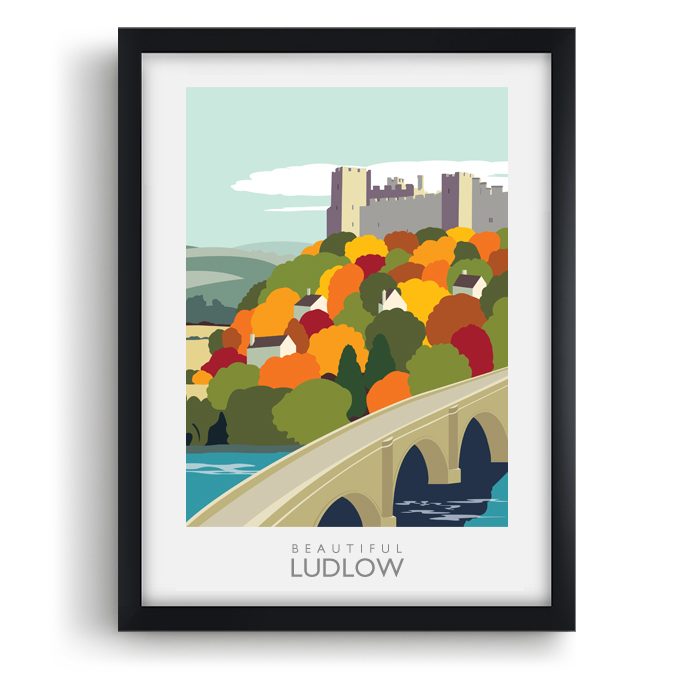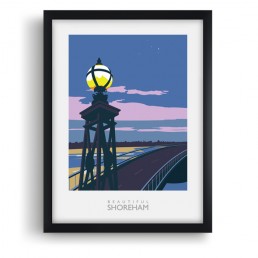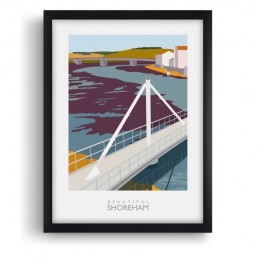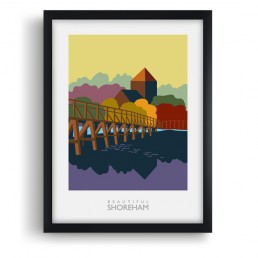Ludlow Castle, Shropshire
Ludlow Castle is the jewel in the crown in this stunning landscape. Surrounded by the river Teme and several beautiful bridges, this 11th century market town has retained its ancient historical heritage with over 500 listed buildings. Sir John Betjeman described Ludlow as “probably the loveliest town in England”. Set between the Clee Hills and Mortimer Forest, the landscape lights up with vivid autumnal colour during October and November. Salmon can be seen making their way up stream during these months too. Our framed Art Prints are available in beech, walnut or black effect frames. They come with mdf backing board and shatterproof styrene plastiglass. ‘Ludlow Castle’ is currently available at A4 and A3 size.
Description
Picture of Ludlow Castle, Shropshire, framed print.
Ludlow Castle, Shropshire, framed print is a new design by Danny McBride. Inspired by the travel posters from the 1920’s and 1930’s this view from the western end of Dinham Bridge celebrates the beauty of this historic town in the autumn months. Our framed art prints are available in black, beech or walnut effect frames. They come with mdf backing board and shatterproof styrene plastiglass. Picture of Ludlow Castle is currently available at A3 and A4 size. We also offer a print only option.
History of Ludlow Castle
Ludlow Castle is the jewel in the crown in this stunning landscape. Surrounded by the river Teme and several beautiful bridges, this 11th century market town has retained its ancient historical heritage with over 500 listed buildings. Sir John Betjeman described Ludlow as “probably the loveliest town in England”. Set between the Clee Hills and Mortimer Forest, the landscape lights up with vivid autumnal colour during October and November. Salmon can be seen making their way up stream during these months too. For information about Ludlow please visit www.ludlow.org.uk
Ludlow Castle is a ruined medieval fortification in the town of the same name in the English county of Shropshire, standing on a promontory overlooking the River Teme. The castle was probably founded by Walter de Lacy after the Norman conquest and was one of the first stone castles to be built in England. During the civil war of the 12th century the castle changed hands several times between the de Lacys and rival claimants, and was further fortified with a Great Tower and a large outer bailey. In the mid-13th century, Ludlow was passed on to Geoffrey de Geneville who rebuilt part of the inner bailey, and the castle played a part in the Second Barons’ War. Roger Mortimer acquired the castle in 1301, further extending the internal complex of buildings, and the Mortimer family went on to hold Ludlow for over a century.
Richard, the Duke of York, inherited the castle in 1425, and it became an important symbol of Yorkist authority during the Wars of the Roses. When Richard’s son, Edward IV, seized the throne in 1461 it passed into the ownership of the Crown. Ludlow Castle was chosen as the seat of the Council in the Marches of Wales, effectively acting as the capital of Wales, and it was extensively renovated throughout the 16th century. By the 17th century the castle was luxuriously appointed, hosting cultural events such as the first performance of John Milton’s masque Comus. Ludlow Castle was held by the Royalists during the English Civil War of the 1640s, until it was besieged and taken by a Parliamentarian army in 1646. The contents of the castle were sold off and a garrison was retained there for much of the interregnum.
With the Restoration of 1660, the Council was reestablished and the castle repaired, but Ludlow never recovered from the civil war years and when the Council was finally abolished in 1689 it fell into neglect. Henry Herbert, the Earl of Powis, leased the property from the Crown in 1772, extensively landscaping the ruins, and his brother-in-law, Edward Clive, bought the castle outright in 1811. A mansion was constructed in the outer bailey but the remainder of the castle was left largely untouched, attracting an increasing number of visitors and becoming a popular location for artists. After 1900, Ludlow Castle was cleared of vegetation and over the course of the century it was extensively repaired by the Powis Estate and government bodies. In the 21st century it is still owned by the Earl of Powis and operated as a tourist attraction.
Additional information
| Weight | 2 kg |
|---|---|
| Dimensions | 780 × 560 × 110 mm |
| Print sizes available | A2 594 x 420mm, A3 420 x 297mm, A4 297 x 210mm |
| Frame colour or print only | Black, Beech, Walnut, PRINT ONLY |








